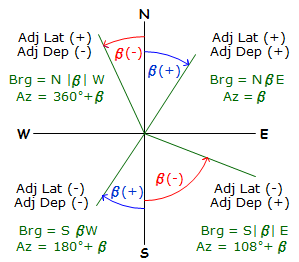Page 3 of 8
3. Adjusted Length and Direction
Regardless of the adjustment method applied, changing a line's Lat and Dep will in turn change the length and direction of the line.
 |
| Figure E-4 Adjusted Length and Direction |
The adjusted length can be computed from the Pythagorean theorem:
 |
Equation E-5 |
Computing direction is a two-step process: (1) Determine β, the angle from the meridian to the line (2) Convert β into a direction based on the line's quadrant.
To determine β:
 |
Equation E-6 |
β falls in the range of -90° to +90°.
The sign on β indicates the direction of turning from the meridian: (+) is clockwise, (-) is counter-clockwise. The combined signs on the adjusted Lat and Dep will identify the line's quadrant.
Figure E-5 shows the quadrant and direction computation for the various mathematic combinations of the adjusted Lat and Dep:
 |
| Figure E-5 Converting ß to a Direction |